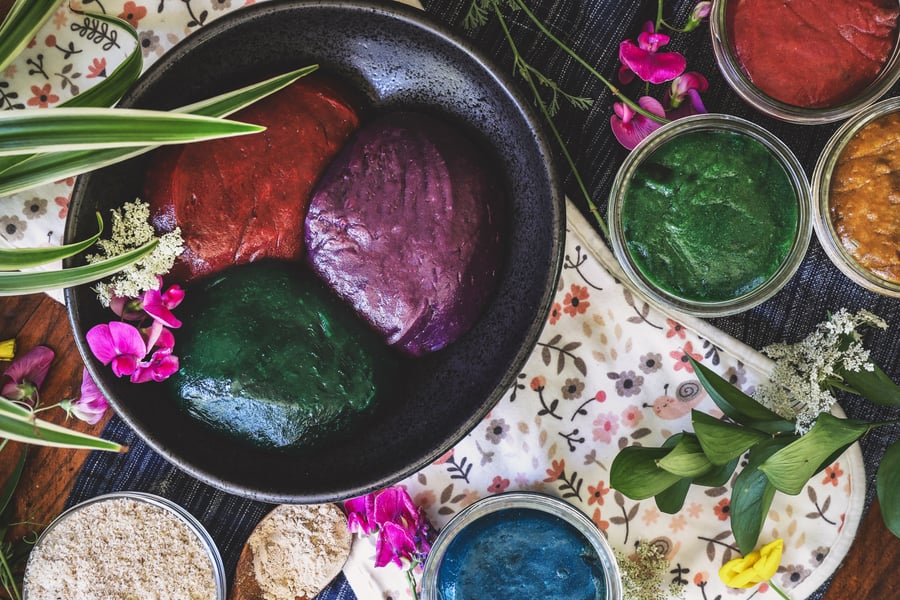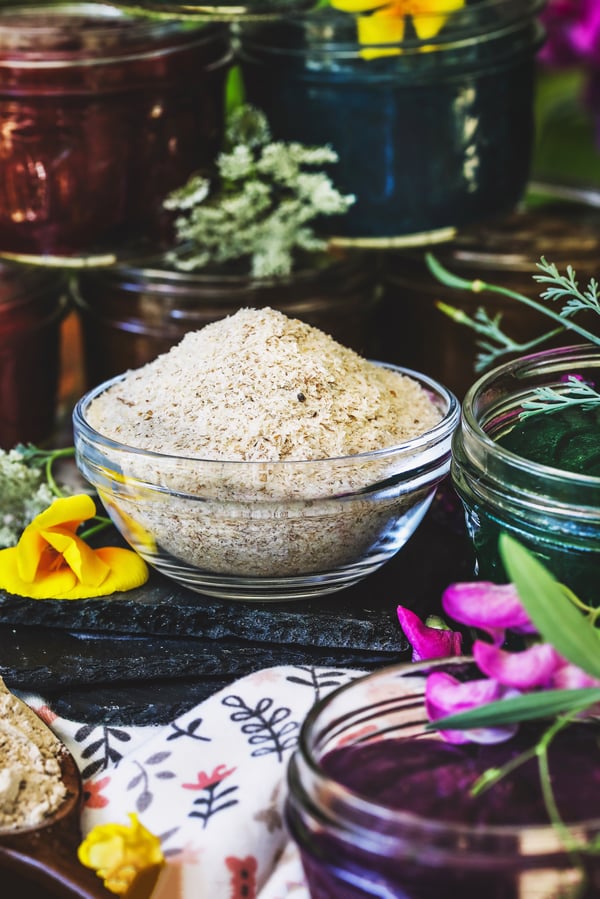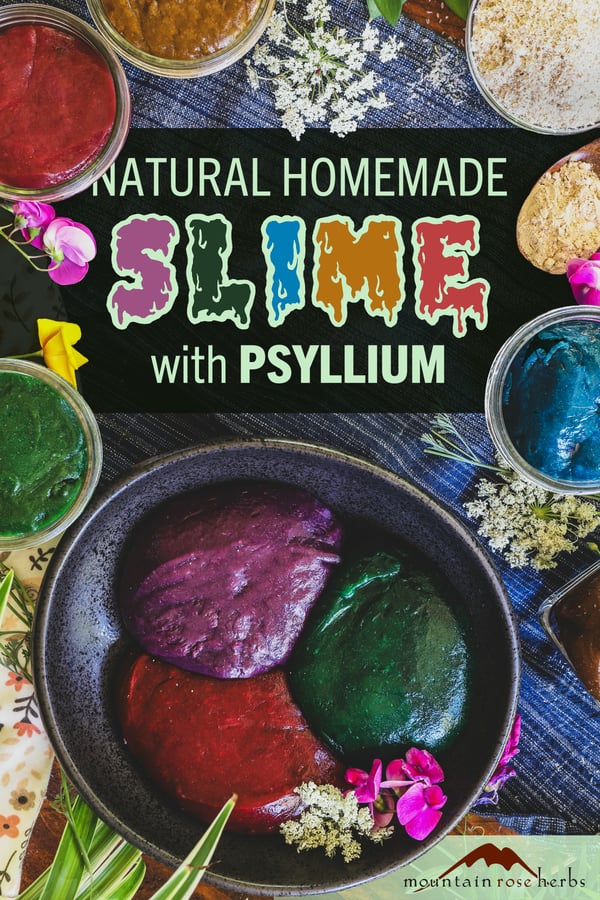Slime—that strange substance that defies Newton’s laws of viscosity—has been a staple in store toy aisles for almost 50 years and the DIY versions have been around almost as long. The typical school-science-project slime recipe involves mixing either borax or contact lens solution with PVA glue and water. The science behind it is a chemical reaction between the polyvinyl acetate in the glue and the borate ions in the contact solution or borax, an action called cross-linking that results in a logic-defying substance that is a whole lot of fun to play with. However, fascinating DIY science aside, too much exposure to boron—which is the base of borax, boric acid, and also, ironically, that contact lens solution—can cause respiratory, skin, and eye irritation, and when ingested can lead to nausea, vomiting, and diarrhea. Note the caution on the front of a box of borax detergent: Caution: Eye irritant, may be harmful if swallowed. Needless to say, that DIY slime hack is not ideal for small children, particularly those who tend to taste-test things. Fortunately for the child in all of us, you can make slime from psyllium husk!
Someone recently gave my granddaughter a slime kit. As I always do, I looked at the packaging to see where this slime was made and what chemicals were used. Because it was made outside the U.S., it listed the country of origin, but no ingredients. It did say nontoxic and child safe, but I’m not the most trusting soul, so I Googled the company, the product, and other products like it in a deeper search to know what the grandbaby was playing with. An hour later, I was able to make an educated guess but had no definite answers. I find this lack of transparency to be worrisome when it comes to something that small children rub into their skin and mucous membranes, and potentially taste-test along the way.
Psyllium Husk: Understanding What Your Kids Are Playing With
Psyllium (also called ispaghula) is made from the husks of the seeds of the Plantago ovata plant. It is one of those botanicals that many of us keep on hand all the time, which makes it easy to whip up a batch of fun slime. But if you’re not one of those people, you may be asking yourself what in the world you’re going to do with several ounces of psyllium husk when it takes as little as a teaspoon to make slime. Thanks so much for asking! When most people think of psyllium husk, they think of it as a high-fiber bulk-forming laxative. However, research shows that psyllium husk offers our bodies myriad benefits.
Digestive System—As well as helping to promote bowel regularity, psyllium husk is a prebiotic that feeds the essential bacteria in our gut. These healthy bacteria produce nutrients for our colon cells, which promote a healthy digestive system and can be absorbed into our bloodstream to improve overall metabolic health.
Heart Health—Adding water-soluble fiber to our diets helps to support healthy cholesterol levels, which can lower the risk of heart disease.
Cooking and Baking—Psyllium husk can be used to make homemade jams, jellies, and nut butters. Because psyllium husk is a hydrocolloid (it binds water and increases the viscosity of a liquid), it also acts as a binder in gluten-free baking, giving dough the elasticity and extensibility it needs to be kneaded, shaped, and proofed properly.
Ultimately, what makes psyllium husk good for our gut and gluten-free baking is also what makes it an excellent ingredient in natural DIY slime: this high-fiber husk expands with liquids and forms a gel that is pure, natural, and safe while being fun to play with.
Although psyllium slime is edible—by which I mean that it is not harmful if eaten by a child who explores the world by tasting everything—it is very high in fiber, so eating too much of it can produce gas, nausea, etc. This is good to know because DIY psyllium slime has a sort of fun jello quality to it that might be enticing for some little kids. However, psyllium slime doesn’t taste very good (if you’ve ever forced your way through a glass of water with psyllium husk dissolved in it, you know what I’m talking about), so there’s a pretty good chance that your kiddos are going to get over their desire to put it in their mouth after the first attempt.
Cautions: Psyllium husk is very high in fiber and must be taken with proper hydration. Also, ingesting too much can cause gastrointestinal side effects. Speak with your doctor if you are taking medications before taking psyllium.
How to Make Easy and natural Slime in Less Than 10 Minutes
You may have seen recipes for “Metamucil slime.” This is a fiber supplement that is made from psyllium husk with added sweeteners, flavorings, etc.; in other words, it’s a more processed and expensive form of the pure, organic psyllium husk you can purchase in natural foods stores, or here at Mountain Rose Herbs. I bring this up because you might find recipes online that call for up to two tablespoons of “psyllium husk powder.” There is pure psyllium husk powder like the one we carry, and then there are the other fiber supplement powders that are made with psyllium husk but also added ingredients. If you use the latter, you may need as much as two tablespoons because each tablespoon has less psyllium than the pure forms.
You can make psyllium slime with either psyllium husk or psyllium husk powder and get similar results. The powder dissolves completely and gives you a very smooth finished product. I don’t always take the time to run the psyllium husk we have on hand through the spice grinder, and have found that that is just fine; it produces a similar slime that is super fun but not quite as evenly smooth.
How much psyllium you use depends on your desired result. Less psyllium will give you that more old-school non-Newtonian fluid experience and adding more will produce more of a fun-jello quality.
Psyllium Slime Recipe: Stovetop and Microwave Methods
Makes 1/2 - 3/4 cup slime.
Ingredients
- 1 - 3 tsp. organic psyllium husk powder
- 1 cup water
- 2 drops food safe liquid food coloring (optional)
Directions
- Combine the ingredients in a pot (stovetop method) or a microwave-safe bowl (microwave method) and whisk to fully incorporate.
- Stovetop method: Heat slowly over medium heat, whisking continuously until mixture just comes to a boil. Remove from heat for 30-60 seconds, still whisking. Put back on the burner and repeat. Continue this heat-then-cool process a couple more times, until slime comes together and psyllium husk is dissolved, about 5 minutes. Remove from heat and set aside to cool completely.
- Microwave method: Microwave on high and watch closely. Stop the microwave frequently, when mixture comes to a boil, thoroughly whisk, then restart the microwave and repeat. Continue this heat-then-cool process until slime comes together and psyllium is dissolved, about 5 minutes. Give it a final whisking and set aside to cool completely.
- Slime is safe to play with when it is completely cool.
- Store at room temperature or in the refrigerator. At room temperature, psyllium slime is shelf stable for about 3 days. If you see any signs of spoilage, simply throw it in your compost.
Pro Tips
- The heat-cool-repeat method produces the smoothest results, but you’ll get almost as good results by simply putting the combined ingredients on the stovetop and heating over medium while whisking constantly to keep it from boiling hard without removing from heat until slime comes together and psyllium husk is dissolved. Set aside to cool as normal.
- Unlike chemical-based slime recipes, psyllium slime doesn’t dry out when exposed to air, so you can store it in an airtight container or not. We once forgot a batch that was left in an uncovered bowl for two days; it was still unspoiled and perfectly playable.
- Whether store-bought or homemade, slime is messy and can leave bits on children’s hands, play mats, tables, rugs, etc. The food coloring in this psyllium slime may also briefly color the skin but is completely safe and is easy to wash off with soap and warm water. It may be helpful to keep a bowl of warm water and a washcloth close at hand for intermittent wipe-offs.
- Additions to slime play can include glitter, confetti, googly eyes, beads, charms, and more. Make alien worlds for superheroes, or underwater landscapes for sea creatures, or galaxies full of sparkling stars and moons. Have fun!
Want Another DIY Idea to Entertain the Kiddos This Summer?
Check out Natural Sensory Play for Children: Hearing
You may also enjoy:
- Homemade Playdough: No Cook Playdough Colored with Herbal Powders
- 9 Herbal Activities for Kids
- Soothing Herbal Recipe for Teething













